Search the Special Collections and Archives Portal
Search Results
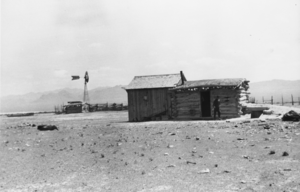
Ed's Well, Railroad Valley, Nevada: photographic print
Date
Archival Collection
Description
From the Nye County, Nevada Photograph Collection (PH-00221) -- Series VII. Other areas in Nye County -- Subseries VII.H. Reed Family (Kawich Mountains, Nevada). Named after Ed Reed, the well is on property originally owned by the 7-L Outfit, who sold it to the United Cattle and Packing Company. The Quinn Canyon Range is visible in the distance.
Image
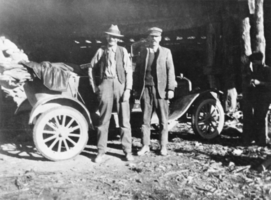
Ed and Orville Knighten Reed Sr. with 1914 Model-T Ford: photographic print
Date
Archival Collection
Description
From the Nye County, Nevada Photograph Collection (PH-00221) -- Series VII. Other areas in Nye County -- Subseries VII.H. Reed Family (Kawich Mountains, Nevada). The Reed brothers were tall men; Ed was about 6'4"and O.K. was about 6', described as big-boned with no fat on their bodies.
Image
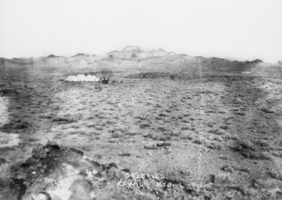
View of Gold Reed: photographic print
Date
Archival Collection
Description
From the Nye County, Nevada Photograph Collection (PH-00221) -- Series VII. Other areas in Nye County -- Subseries VII.H. Reed Family (Kawich Mountains, Nevada). Gold Reed, Kawich Mountains, Nye County, Nevada, probably about 1905. It was with a mine in Gold Reed that O.K. Reed made the money to purchase the ranch at Hawes Canyon. The ore at the mine was so rich that a person could stand off 50 or 60 feet and see the gold in the original outcropping; some of the ore sold for $1,000 a ton. Reed was partners in the mine with Jack May and a Mr.Wardle, Tonopah resident Austin Wardle’s father. Jack May and Reed were married to sisters, Mabel and Maude Hanley.
Image
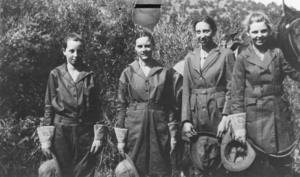
Girls who lived at O.K. Reed's ranch at Hawes Canyon: photographic print
Date
Archival Collection
Description
From the Nye County, Nevada Photograph Collection (PH-00221) -- Series VII. Other areas in Nye County -- Subseries VII.H. Reed Family (Kawich Mountains, Nevada). Left to right, Lucille Reed, Catherine May, Florence Reed, and Helen Reed. The gloves the girls are wearing were made by Indians living in the Hawes Canyon area.
Image
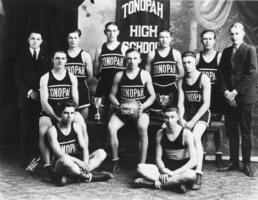
Tonopah's Championship Basketball Team: photographic print
Date
Archival Collection
Description
From the Nye County, Nevada Photograph Collection (PH-00221) -- Series VII. Other areas in Nye County -- Subseries VII.H. Reed Family (Kawich Mountains, Nevada). Credit: Franks Photos. Back row, standing, from left, Coach Snyder, John Casselli, McGuire, Jimmy Burns, Paul Richards, and Manager Bernard Fuetsch. Second row, Bill Dumble, John Starr, and Ed Slavin. Sitting in front, Chester Geyer and George Brown. While playing its Last game in Ely that season the team received a telegram from home staying, "Beat Ely and Chicago next." About $2,500 was raised in a few hours in Tonopah to send the team to participate in a tournament in Chicago. The Tonopah lads, however, did not fare well in Chicago against older and bigger competitions.
Image
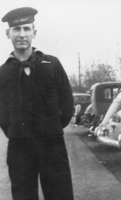
Solan Terrell home on leave from the U.S. Navy: photographic print
Date
Archival Collection
Description
From the Nye County, Nevada Photograph Collection (PH-00221) -- Series VI. Tonopah, Nevada -- Subseries VI.D. Terrell Family.
Image
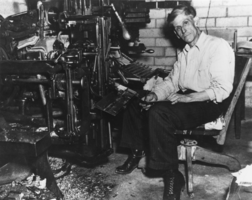
Clyde Rufus Terrell seated at the linotype machine at the Tonopah Times Bonanza: photographic print
Date
Archival Collection
Description
This photo was taken about two years prior to his death in 1950. From the Nye County, Nevada Photograph Collection (PH-00221) -- Series VI. Tonopah, Nevada -- Subseries VI.D. Terrell Family. Clyde Rufus Terrell seated at the linotype machine at the Tonopah Times Bonanza, which he owned, Tonopah, Nevada. Terrell would compose stories for the newspaper at the linotype keyboard.
Image
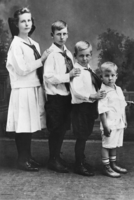
Children of Clyde Rufus Terrell and Kitty Wheeler Terrell: photographic print
Date
Archival Collection
Description
From the Nye County, Nevada Photograph Collection (PH-00221) -- Series VI. Tonopah, Nevada -- Subseries VI.D. Terrell Family. L-R: Clydene Terrell, Don Wheeler Terrell, Starle William Terrell, Solan Chester Terrell, children of Clyde Rufus Terrell and Kitty Wheeler Terrell.
Image
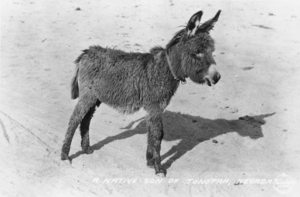
Postcard of burro: photographic print
Date
Archival Collection
Description
From the Nye County, Nevada Photograph Collection (PH-00221) -- Series VI. Tonopah, Nevada -- Subseries VI.D. Terrell Family. A picture postcard with the caption, "A native son of Tonopah, Nevada." Described by Solan Terrell as the most "cantankerous animal that was ever born," also one of the most intelligent. During the 1920s and 1930s burros ran loose in the streets of Tonopah, raiding garbage cans and providing an endless source of entertainment to the children. While in the Navy during World War II, Solan Terrell won $5 when he bet a fellow that Nevada had mountain canaries weighing 400 or 500 pounds. When Terrell produced a picture of the burro with the caption, "A native Nevada mountain canary," the sucker had no choice but to pay up.
Image
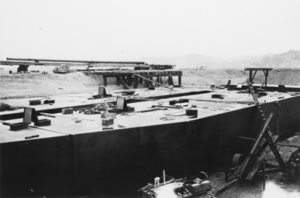
Pontoon from the dredge constructed at Manhattan: photographic print
Date
Archival Collection
Description
From the Nye County, Nevada Photograph Collection (PH-00221) -- Series VI. Tonopah, Nevada -- Subseries VI.D. Terrell Family. A pontoon from the dredge constructed at Manhattan, Nevada, prior to World War II. A large hole was dug to impound water. Water was then piped to Manhattan from across the valley at Peavine and fed into the hole. The superstructure was constructed atop the pontoon, and the dredge, with buskets in front, scooped the gravel out as it moved from the lower end of the gulch to the upper end, about 1-1/2 miles. The gravel that was scooped out was processed for gold on the dredge and fed out back of the dredge when processing was completed.
Image
